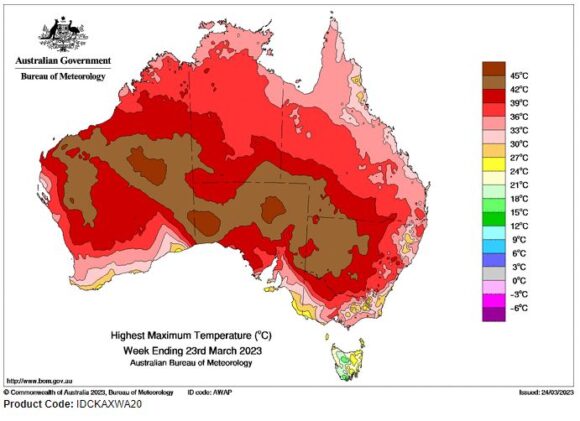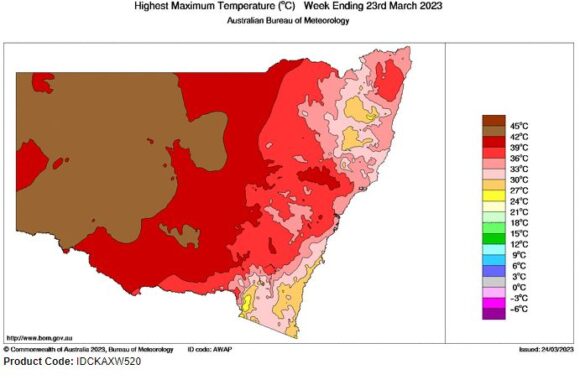A significant burst of heat traversed across south east Australia during the period 16 to the 20 March 2023 which is likely to be the last major burst of heat for this spring / summer / early autumn period across such regions.
As typical with most of these events, the strongest burst of heat was felt well inland away from the coast with some far western towns and regions even experiencing heatwave conditions.

For the Sydney region, while there was a 5 day spell where maximum daytime temperatures reached 30C or higher across much of the greater west, the hottest day was experienced during Sunday 19 March where maximum temperatures reached at least 38C. This made it the second hottest day for March and across the whole spring / summer / early autumn period.
Key events of this are:
1 - Heatwave like conditions prevailed across far western New South Wales with places like Bourke experiencing 5 consecutive days where maximum temperatures exceeded 39C including 4 days where maximum temperatures exceeded 40C.
2 - Western Sydney experienced its second hottest day for March and the second time this month where a daytime temperature reached 38C or higher.
3 - Coastal areas missed out and such heat failed to reach the New South Wales south coast due to a cool south east wind change that moved north along the coast during the day.
This came ahead of a cool change. The change was such that it broke up the heat and it is likely that such temperatures will not again be reached until well into spring 2023.
Following the change, more benign weather took hold including the development of cloud, some thunderstorm activity, showers and rain events at various places.
The highest maximum daytime temperature for Sunday 19 March 2023 across Western Sydney was:
Badgerys Creek - Briefly reached 40.2C.
Note - The weather station at Badgerys Creek has recorded 2 days this month where the maximum daytime temperature soared to 40C with 40.4C on the 6 of March. This is remarkable as the hottest days this season have occurred in March and not during the traditional December to February period.
Penrith 39.5C
Camden 39.3C.
Horsley Park 38.3C.
Bankstown 38.1C.
Such heat failed to penetrate further east due to the north east sea breezes prevailing along coastal areas.
The heat was strongest across inland New South Wales and heatwave like conditions prevailed across the far west of the state. As shown in the table below for a few selected centres:
| Town / City | 16 March | 17 March | 18 March | 19 March | 20 March |
| Bourke | 39.6c | 40.6C | 42.9C | 42.5C | 41.3C |
| Dubbo | 36.4C | 34.6C | 38.4C | 39.6C | 38.6C |
| Forbes | 36.7C | 32.7C | 37.8C | 41.1C | 39.8C |
| Goulburn | No record | 31.1C | 33C | 37.6C | 18.6C |
| Hay | 33.6C | 31.7C | 41.7C | 39.9C | 30.4C |
| Parkes | 34.1C | 31.2C | 36C | 39.1C | 38.1C |
| Pooncarie | 36.5C | 35.8C | 43.2C | 38.8C | 31C |
| Tibooburra | 40.4C | 40.7C | 42C | 41.6C | 40.1C |
| White Cliffs | 40.8C | 37C | 42.5C | 43.8C | 38C |
| Penrith | 37.6C | 35.1C | 34.6C | 39.5C | 23.9C |
| Sydney | 36.2C | 31.6C | 29.1C | 28.9C | 23.6C |
Note:- Tibooburra located in far north west New South Wales also recorded 38.7C on the 21/3, 39.3C on the 22/3, 40C on the 23/3 and 35.9C on the 24/3. The cool change failed to reach this part of the state.
The dome of heat was much weaker for areas along the southern areas of the state including the Murray River region and across Victoria. For such areas, only one hot day occurred generally being March 18.

Attached are the maximum temperature plots generated on Water and the Land showing areas of Australia and New South Wales that recorded the strongest heat for the week ending Friday 24 March 2023.
